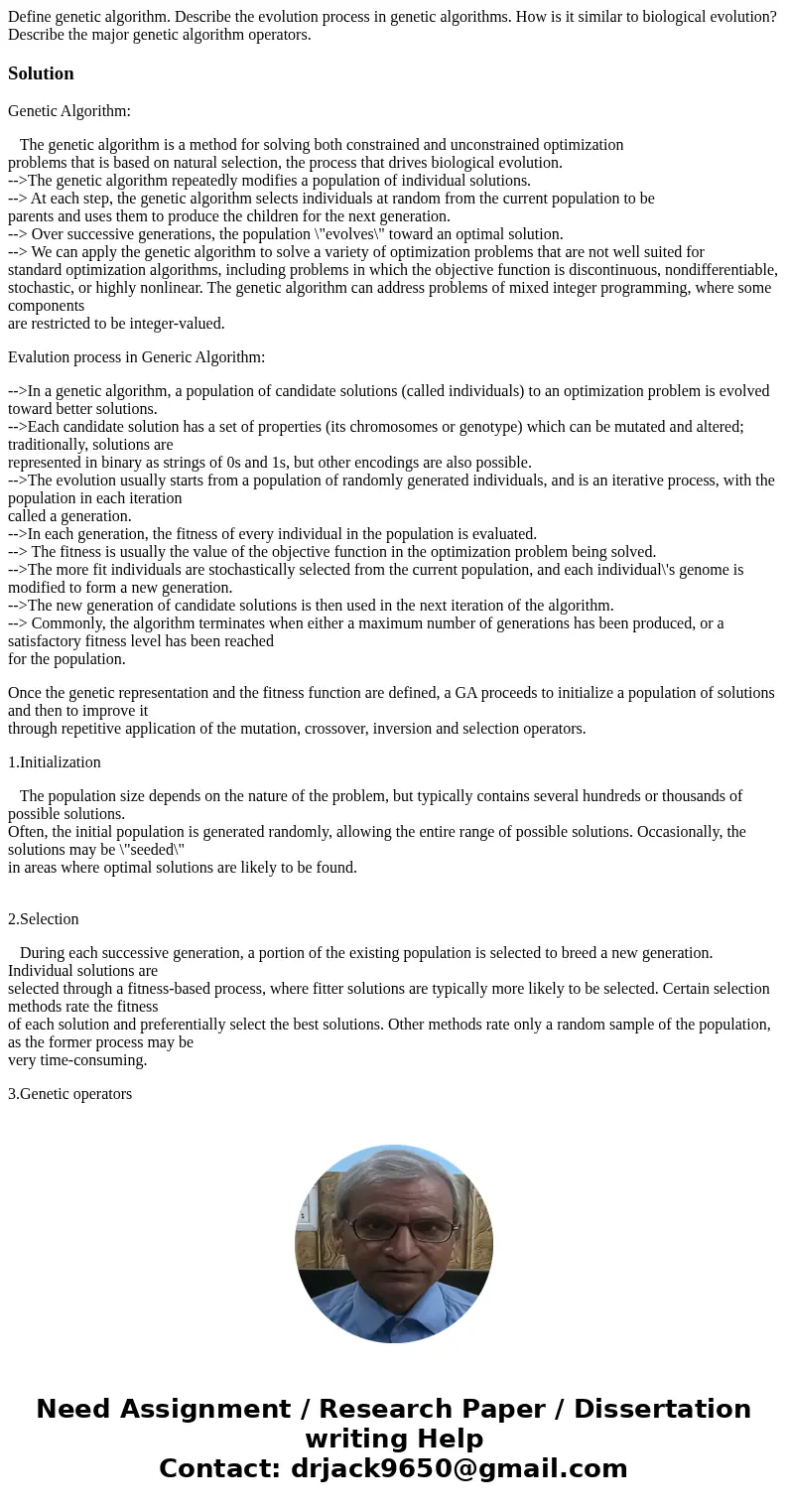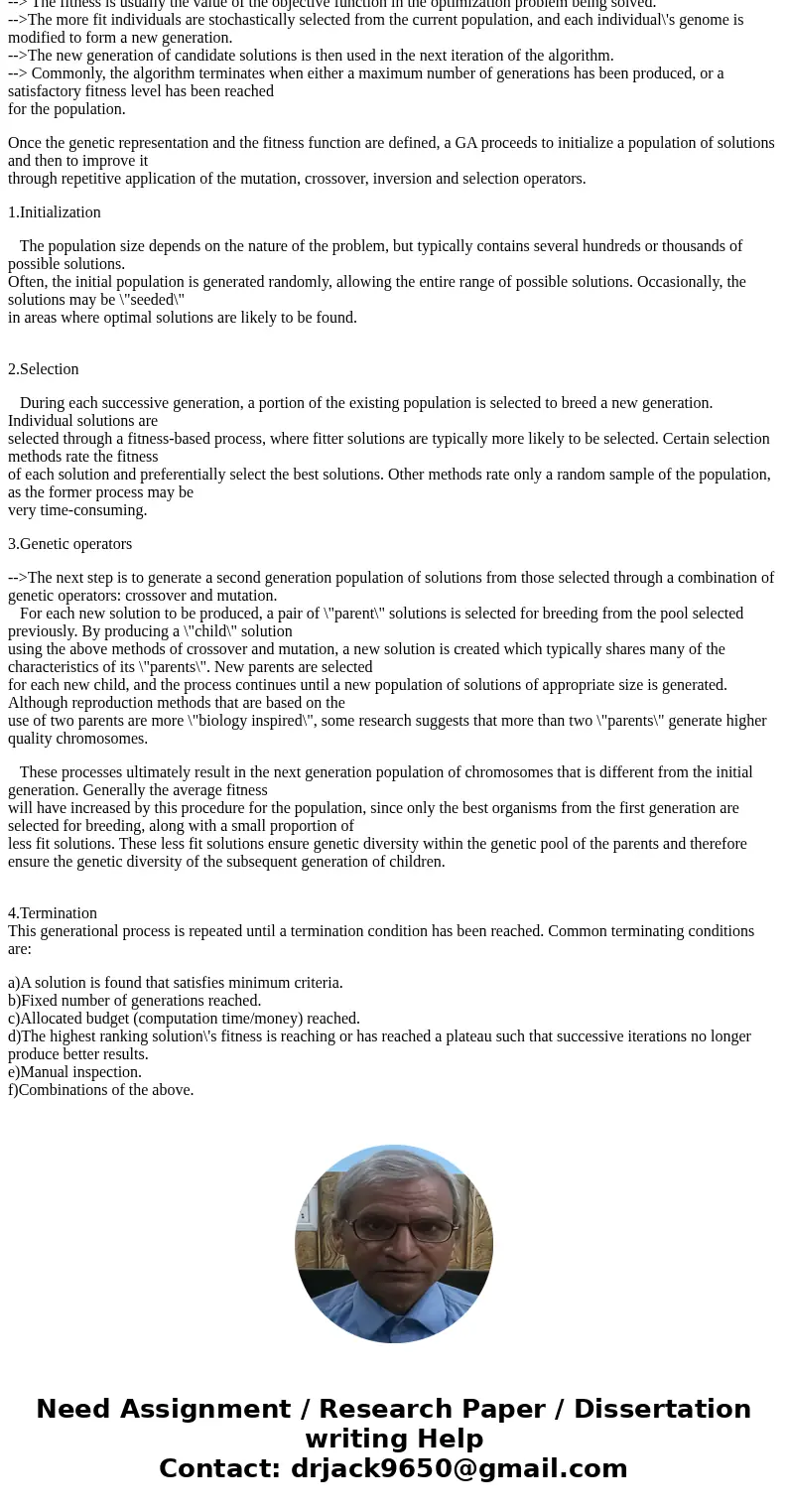Define genetic algorithm Describe the evolution process in g
Define genetic algorithm. Describe the evolution process in genetic algorithms. How is it similar to biological evolution? Describe the major genetic algorithm operators.
Solution
Genetic Algorithm:
The genetic algorithm is a method for solving both constrained and unconstrained optimization
problems that is based on natural selection, the process that drives biological evolution.
-->The genetic algorithm repeatedly modifies a population of individual solutions.
--> At each step, the genetic algorithm selects individuals at random from the current population to be
parents and uses them to produce the children for the next generation.
--> Over successive generations, the population \"evolves\" toward an optimal solution.
--> We can apply the genetic algorithm to solve a variety of optimization problems that are not well suited for
standard optimization algorithms, including problems in which the objective function is discontinuous, nondifferentiable,
stochastic, or highly nonlinear. The genetic algorithm can address problems of mixed integer programming, where some components
are restricted to be integer-valued.
Evalution process in Generic Algorithm:
-->In a genetic algorithm, a population of candidate solutions (called individuals) to an optimization problem is evolved toward better solutions.
-->Each candidate solution has a set of properties (its chromosomes or genotype) which can be mutated and altered; traditionally, solutions are
represented in binary as strings of 0s and 1s, but other encodings are also possible.
-->The evolution usually starts from a population of randomly generated individuals, and is an iterative process, with the population in each iteration
called a generation.
-->In each generation, the fitness of every individual in the population is evaluated.
--> The fitness is usually the value of the objective function in the optimization problem being solved.
-->The more fit individuals are stochastically selected from the current population, and each individual\'s genome is modified to form a new generation.
-->The new generation of candidate solutions is then used in the next iteration of the algorithm.
--> Commonly, the algorithm terminates when either a maximum number of generations has been produced, or a satisfactory fitness level has been reached
for the population.
Once the genetic representation and the fitness function are defined, a GA proceeds to initialize a population of solutions and then to improve it
through repetitive application of the mutation, crossover, inversion and selection operators.
1.Initialization
The population size depends on the nature of the problem, but typically contains several hundreds or thousands of possible solutions.
Often, the initial population is generated randomly, allowing the entire range of possible solutions. Occasionally, the solutions may be \"seeded\"
in areas where optimal solutions are likely to be found.
2.Selection
During each successive generation, a portion of the existing population is selected to breed a new generation. Individual solutions are
selected through a fitness-based process, where fitter solutions are typically more likely to be selected. Certain selection methods rate the fitness
of each solution and preferentially select the best solutions. Other methods rate only a random sample of the population, as the former process may be
very time-consuming.
3.Genetic operators
-->The next step is to generate a second generation population of solutions from those selected through a combination of genetic operators: crossover and mutation.
For each new solution to be produced, a pair of \"parent\" solutions is selected for breeding from the pool selected previously. By producing a \"child\" solution
using the above methods of crossover and mutation, a new solution is created which typically shares many of the characteristics of its \"parents\". New parents are selected
for each new child, and the process continues until a new population of solutions of appropriate size is generated. Although reproduction methods that are based on the
use of two parents are more \"biology inspired\", some research suggests that more than two \"parents\" generate higher quality chromosomes.
These processes ultimately result in the next generation population of chromosomes that is different from the initial generation. Generally the average fitness
will have increased by this procedure for the population, since only the best organisms from the first generation are selected for breeding, along with a small proportion of
less fit solutions. These less fit solutions ensure genetic diversity within the genetic pool of the parents and therefore ensure the genetic diversity of the subsequent generation of children.
4.Termination
This generational process is repeated until a termination condition has been reached. Common terminating conditions are:
a)A solution is found that satisfies minimum criteria.
b)Fixed number of generations reached.
c)Allocated budget (computation time/money) reached.
d)The highest ranking solution\'s fitness is reaching or has reached a plateau such that successive iterations no longer produce better results.
e)Manual inspection.
f)Combinations of the above.


 Homework Sourse
Homework Sourse